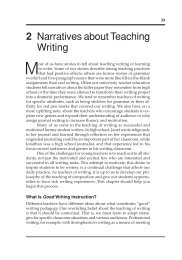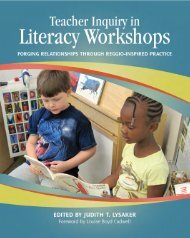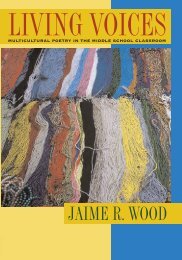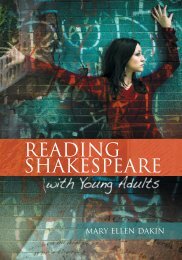Graphic novel Spread - National Council of Teachers of English
Graphic novel Spread - National Council of Teachers of English
Graphic novel Spread - National Council of Teachers of English
- No tags were found...
Create successful ePaper yourself
Turn your PDF publications into a flip-book with our unique Google optimized e-Paper software.
Introduction—Carving a Niche 23<br />
Fiske, E. (Ed.). (1999). Champions <strong>of</strong> change: The impact <strong>of</strong> the arts on learning.<br />
Washington, DC: Arts Education Partnership.<br />
Freire, P., & Macedo, D. (1987). Literacy: Reading the word and the world. South<br />
Hadley, MA: Bergin & Garvey.<br />
Frey, N., & Fisher, D. (2004). Using graphic <strong>novel</strong>s, anime, and the Internet in<br />
an urban high school. <strong>English</strong> Journal, 93, 19–44.<br />
Galley, M. (2004). Going “graphic”: Educators tiptoe into realm <strong>of</strong> comics.<br />
Education Week, 23, 6.<br />
Gallo, D. (2004). Bold books for innovative teaching. <strong>English</strong> Journal, 93(5),<br />
119–24.<br />
Gambrell, L. B., & Jawitz, P. B. (1993). Mental imagery, text illustrations, and<br />
children’s story comprehension and recall. Reading Research Quarterly,<br />
28, 264–76.<br />
Giroux, H. (1992). Border crossings: Cultural workers and the politics <strong>of</strong><br />
education. New York: Routledge.<br />
Goldsmith, F. (2003). Spotlight on graphic <strong>novel</strong>s—<strong>Graphic</strong> <strong>novel</strong>s as literature.<br />
The Booklist, 99, 986–88.<br />
Goodlad, J. I. (2004). A place called school. New York: McGraw-Hill.<br />
Gorman, M. (2003). Getting graphic! Using graphic <strong>novel</strong>s to promote literacy<br />
with preteens and teens. Worthington, OH: Linworth.<br />
Greene, M. (1995). Releasing the imagination: Essays on education, the arts, and<br />
social change. San Francisco: Jossey-Bass.<br />
Grillo, T. (2005, February). Reaching teens: Back to the future. NEAToday, 26–<br />
28.<br />
Hughes, S. (2005, April 8). Comic book science in the classroom. <strong>National</strong><br />
Public Radio’s Morning Edition. Retrieved April 8, 2005, from http://<br />
www.npr.org<br />
Ingram, P. (2003). Hooks for reluctant readers. Education Week, 23(13), 26.<br />
International Visual Literacy Association. What is visual literacy Retrieved<br />
October 15, 2003, from http://www.ivla.org/<br />
org_what_vis_lit.htm#definition<br />
Krashen, S. D. (1996). Every person a reader: An alternative to the California task<br />
force report on reading. Culver City, CA: Language Education Associates.<br />
Krashen, S. D. (2004). The power <strong>of</strong> reading: Insights from the research (2nd ed.).<br />
Westport, CT: Libraries Unlimited.<br />
Lavin, M. R. (1998). Comic books and graphic <strong>novel</strong>s for libraries: What to<br />
buy. Serials Review, 24(2), 31–46.<br />
Leckbee, J. (2004). Response to “What activity has been most effective in<br />
assisting high school students to read successfully” Teacher to<br />
teacher column, <strong>English</strong> Journal, 93(5), 21.
















